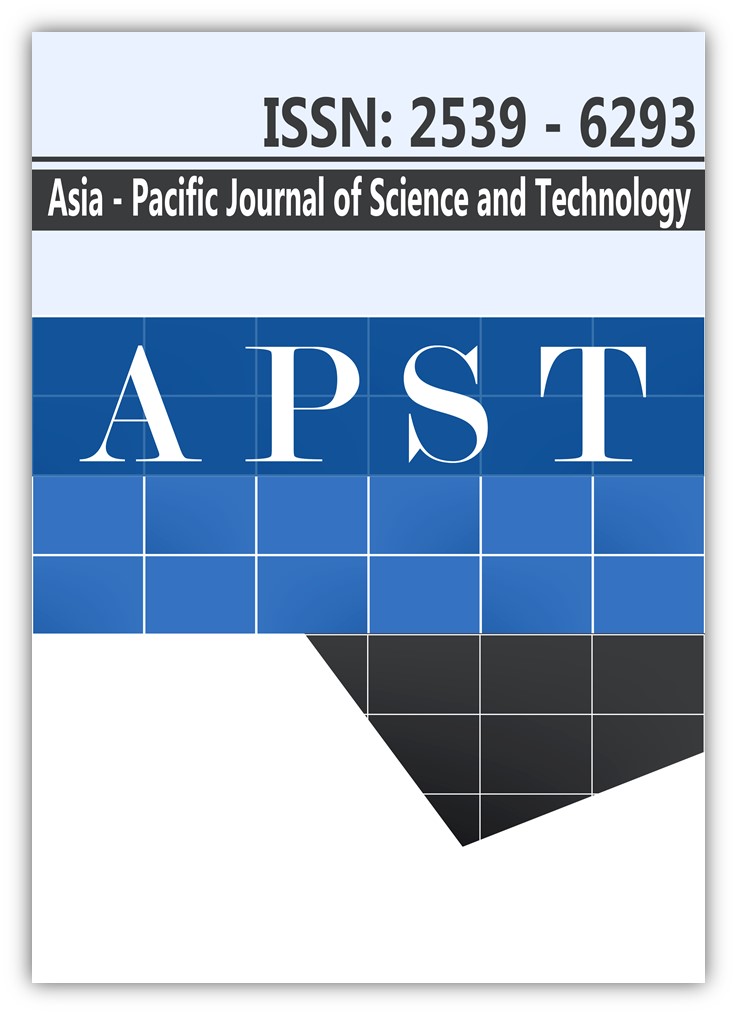Long term stability of immunophenotypic T cell subsets from whole blood of tacrolimus-based therapy kidney transplantation patients and healthy volunteers by flow cytometric analysis
Main Article Content
Abstract
Flow cytometric analysis has become popular in immunology to identify T cells subsets. Unfortunately, using this technique has been limited by requiring testing blood samples within 24 hours after collection. Therefore, preserving the stability of lymphocytes may be useful to prolong blood samples before analysis by flow cytometry. The aim of this study was to validate long term stability of T cell subsets (cell surface markers, CD3+, CD3+CD4+ and CD3+CD8+, and intracellular marker, CD4+IL-2) by flow cytometric technique using whole blood samples from tacrolimus-based therapy kidney transplantation patients and healthy volunteers. Whole blood samples were collected from 10 tacrolimus-based therapy kidney transplantation patients and 10 healthy volunteers, separated into 2 groups by stored at 4 ̊C and -20 ̊C, and then analyzed by flow cytometry at day 1, day 3, day 7, day 15 and day 30 after collection. The percentage of T cell subsets were recorded at each time interval. The percentage of CD3+CD4+ subset in patient group was not significantly different up to 30 days after blood sample collection storage in both 4 ̊C (day 1 = 45.88 ± 4.78 VS day 30 = 41.32 ± 4.03) and -20 ̊C (day 1 = 42.76 ± 3.54 VS day 30 = 38.52 ± 2.97), P > 0.05. CD3+, CD3+CD8+, and CD4+IL-2 subset were not significantly different in both groups. Moreover, CD3+, CD3+CD4+, CD3+CD8+, and CD4+IL-2 subsets were significantly different between patient and healthy groups. These findings indicate that whole blood samples could preserve all cells for 30 days before flow cytometric analysis is done for both the patient and the healthy group.
Article Details
References
[2] Davis C, Wu X, Li W, Fan H, Reddy M. Stability of immunophenotypic markers in fixed peripheral blood for extended analysis using flow cytometry. J Immunol Methods. 2011;363(2):158-165.
[3] McCaughan JA, Patterson CC, Maxwell AP, Courtney AE. Factors influencing survival after kidney transplant failure. Transplant Res. 2014;3(1):18.
[4] Gaynor JJ, Ciancio G, Guerra G, Sageshima J, Roth D, Goldstein MJ, et al. Lower tacrolimus trough levels are associated with subsequently higher acute rejection risk during the first 12 months after kidney transplantation. Transpl Int. 2016;29(2):21-226.
[5] Halloran PF. Immunosuppressive drugs for kidney transplantation. N Engl J Med. 2004;351:2715-2729
[6] Steinebrunner N, Sandig C, Sommerer C, Hinz U, Giese T, Stremmel W, et al. Pharmacodynamic monitoring of nuclear factor of activated T cell-regulated gene expression in liver allograft recipients on immunosuppressive therapy with calcineurin inhibitors in the course of time and correlation with acute rejection episodes--a prospe. Ann Transplant. 2014;19:32-40.
[7] Zahn A, Schott N, Hinz U, Stremmel W, Schmidt J, Ganten T, et al. Immunomonitoring of nuclear factor of activated T cells–regulated gene expression: The first clinical trial in liver allograft recipients. Liver Transplant. 2011;17(4):466-473.
[8] Kannegieter NM, Hesselink DA, Dieterich M, de Graav GN, Kraaijeveld R, Baan CC. Analysis of NFATc1 amplification in T cells for pharmacodynamic monitoring of tacrolimus in kidney transplant recipients. PLOS One. 2018;13(7):1-15.
[9] Geng L, Liu J, Huang J, Lin B, Yu S, Shen T, et al. A high frequency of CD8(+)CD28(-) T-suppressor cells contributes to maintaining stable graft function and reducing immunosuppressant dosage after liver transplantation. Int J Med Sci. 2018;15(9):892-899.
[10] Härtel C, Schumacher N, Fricke L, Ebel B, Kirchner H, Müller-Steinhardt M. Sensitivity of Whole-Blood T Lymphocytes in Individual Patients to Tacrolimus (FK 506): Impact of Interleukin-2 mRNA Expression as Surrogate Measure of Immunosuppressive Effect. Clin Chem. 2004;50(1):141-151.
[11] Kapturczak MH, Meier-Kriesche HU, Kaplan B. Pharmacology of calcineurin antagonists. Transplant Proc. 2004;36(2) Suppl:S25-32.
[12] Hamida F Ben, Barbouch S, Bardi R, Helal I, Kaaroud H, Fatma L Ben, et al. Acute rejection episodes after kidney transplantation. Saudi J Kidney Dis Transpl. 2009;20(3):370-374.
[13] Levine AG, Mendoza A, Hemmers S, Moltedo B, Niec RE, Schizas M, et al. Stability and function of regulatory T cells expressing the transcription factor T-bet. Nature. 2017;546:421.
[14] Jalla S, Sazawal S, Deb S, Black robert E, Das SN, Sarkar A, et al. Enumeration of lymphocyte subsets using flow cytometry: Effect of storage before and after staining in a developing country setting. Indian J Clin Biochem. 2004;19(2):95-99.
[15] Deenadayalan A, Maddineni P, Raja A. Comparison of whole blood and PBMC assays for T-cell functional analysis. BMC Res Notes. 2013;6(1):120.
[16] Alam I, Goldeck D, Larbi A, Pawelec G. Flow cytometric lymphocyte subset analysis using material from frozen whole blood. J Immunoass Immunochem. 2012;33(2):128-139.
[17] Klaasen RA, Bergan S, Bremer S, Daleq L, Andersen AM, Midtvedt K, et al. Longitudinal study of tcrolimus in lymphocytes during the first year after kidney transplantation. Ther Drug Monit. 2018;40:558-566.
[18] Silva D, Ponte CGG, Hacker MA, Antas PRZ. A whole blood assay as a simple, broad assessment of cytokines and chemokines to evaluate human immune responses to Mycobacterium tuberculosis antigens. Acta Trop. 2013;127(2):75-81.
[19] Harrison D, Ward R, Bastow S, Parr A, Macro S, Wallace PK. Interlaboratory comparison of the TransFix®/EDTA vacuum blood collection tube with the 5 mL Cyto-Chex® BCT. Cytom Part B Clin Cytom. 2018.
[20] Truett AA, Letizia A, Malyangu E, Sinyangwe F, Morales BN, Crum NF, et al. Efficacy of Cyto-Chex blood preservative for delayed manual CD4 testing using Dynal T4 Quant CD4 test among HIV-infected persons in Zambia. J Acquir Immune Defic Syndr. 2006;41(2):168-174.
[21] Warrino DE, DeGennaro LJ, Hanson M, Swindells S, Pirruccello SJ, Ryan WL. Stabilization of white blood cells and immunologic markers for extended analysis using flow cytometry. J Immunol Methods. 2005;305(2):107-119.


